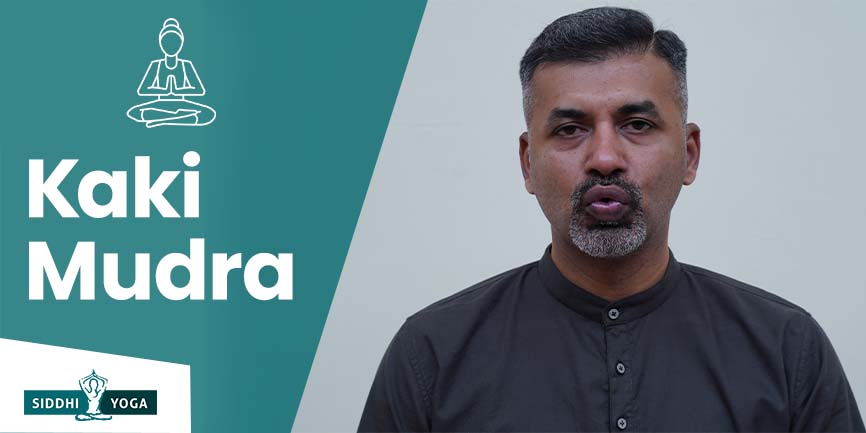
What is the meaning of kaki mudra, and what are its benefits? This article explores everything you need to know about this Mudra.
Definition – What is Kaki Mudra and its Meaning, References, and Mythology?
Kaki Mudra is one of the Yogic Mudras or sacred gestures/seals. Let us simplify its meaning.
Kaki Mudra is made of two different words. Let us break it down into two:
Kaki – the word “Kaki” represents a “crow” in the Sanskrit language,
Mudra – As we are familiar with the word “Mudra,” it represents a Yogic gesture or seal.
Apart from this name, some people also call it Mudra for longevity.
This Mudra is also known as the Crow’s Beak as this Mudra is based on a specific movement of your lips that involves making a pout with your mouth. This pout looks quite similar to a beak. This Mudra is sometimes included in face Yoga as well.
It helps activate several facial muscles, including the Platysma muscle, which is often responsible for the double chin problem. The double chin is caused by fat deposition into the Platysma muscle. So, if done right with proper muscle activation, Kaki Mudra can also help resolve the double chin problem. As it also activates other facial muscles, this helps keep the skin active and toned and helps avoid wrinkles and skin aging.
Yogis also used Kaki Mudra to learn breath retention. So, it is considered one of the best breathing techniques. Due to its amazing benefits and similarity with other Pranayamas, such as Sheetaliya and Seetakariya Pranayamas, it is also considered one of the Pranayamas.
This Mudra practice has a cool and calm effect on our bodies. This Mudra calms the mind, and in addition, it also helps to soothe mental tensions and stress. It is also believed that practicing this Mudra can help to alleviate high blood pressure as well.
Alternate Names of Kaki Mudra
The Crow’s Beak or Crow gesture, Mudra for longevity.
How to Do Kaki Mudra?
- This Mudra is based on the specific movement of our lips. You make a pout that looks similar to a Crow’s beak.
- You can practice this Mudra while seated in a comfortable meditative posture, such as Vajrasana (Thunderbolt Pose), or Swastikasana (Auspicious Pose), or you can practice it while assuming a standing posture, such as Samsthiti or Mountain Pose.
- This Mudra is often practiced with the Shanmukhi Mudra. However, this depends on whether the practitioner wants to add Shanmukhi Mudra. If you want to practice Kaki Mudra with Shanmukhi Mudra, then you can follow the steps of practicing Shanmukhi Mudra.
- Now, you can start by making a pout with your lips so that it should resemble a Crow’s beak.
- Then, assume the Nasikagra or Nasagra Drishti, inhale through the mouth, and fill your mouth with air as much as possible. While doing so, you might experience a sense of coolness in your mouth.
- Let your cheeks expand out and retain your breath.
- While retaining your breath, close the nostrils with your middle fingers in Shanmukhi Mudra. And then, gently bring your chin close to the chest so that it forms a Chin lock or Jalandhar Bandha.
- To do so, release your nostrils first. Retain your breath as long as you can. When you cannot hold it any longer, slowly release the Chin lock, bring your head back, and slowly exhale your breath out through the nostrils.
- Repeat it for 10-12 rounds or as your Yoga guru prescribes.
Kaki Mudra Benefits

- This Mudra is also considered equivalent to a Pranayama such as Shitali and Seetakariya Pranayama. So, one can achieve a good result by practicing this Mudra, especially those who cannot practice Shitali Pranayama because they cannot furl their tongues. It can help to increase Prana Shakti, the vital force in our bodies.
- This helps to bring calmness and coolness into the body. So, practicing in the summer can help make our body cooler.
- Due to its cooling effects, it is believed to help alleviate high blood pressure problems.
- This Mudra is believed to activate the Throat Chakra, which can help to balance the thyroid gland’s secretion.
- This Mudra activates many of our facial muscles, so it helps tone them up. It can even help to deal with the double chin problem, as if done correctly, it can activate the Platysma muscle. If we burn fat from the Platysma muscle, it can help to alleviate the double chin problem.
- Practice this Mudra brings stillness and calmness.
- Practicing this Mudra can help to avoid wrinkles and signs of aging.
Kaki Mudra Precautions and Contraindications

However, there are a few things to consider:
- You should discontinue the practice if you experience dizziness while retaining your breath.
- Do not practice it in a polluted environment. Because you are exhaling the air in your mouth, and if it contains pollution particles, it could potentially harm you.
- People who are in depression should avoid practicing this.
- If you are suffering from a low blood pressure problem, do not practice this.
- If you have chronic constipation, then do not practice this.
- This Mudra brings a sense of coolness into the body, so it should not be practiced in cold weather conditions.
When and how long to do Kaki Mudra?
- This Mudra can be practiced to keep your body cool and calm.
- This Mudra can be practiced if you are someone who cannot furl his tongue to practice Shitali Pranayama. Then practicing this can help to achieve similar results.
- This can be practiced to delay wrinkles and signs of aging. It can help to alleviate double chin issues as well.
- You can practice this to bring calmness.
Morning is the ideal time to do any yoga or Mudra. Our brain is at its best in the morning and during the daytime. So, you are more likely to be able to concentrate easily. Therefore, you should practice this Mudra from 4 am and 6 am to get the most effective outcomes.
If you are having difficulty with this during the morning, you can do this Mudra later in the evening too.
Based on research, the best way to practice an exercise for at least 10-20 minutes is to get the best benefits of that Mudra. Practicing this Mudra for a minimum of 3-5 times daily is recommended. It’s up to you whether you wish to complete it in one stretch or in two threes that last between 1 to 5 minutes.
Breathing in Kaki Mudra
This form of breathing exercise is often considered equal to Pranayamas.
Affirmation in Kaki Mudra
While practicing this, keep a positive intention. Start with:
“I am wise enough to listen to my intuitions and act upon them.”
Conclusion
The kaki mudra is one of many ancient techniques that can be used to improve your health and well-being. This Mudra helps to cleanse the body and mind, relieving stress and tension. If you’re interested in learning more about mudras and how to use them for better health, check out our Mudras Certification Course. In this course, you’ll learn all 108 mudras, their benefits, and how to use them effectively.